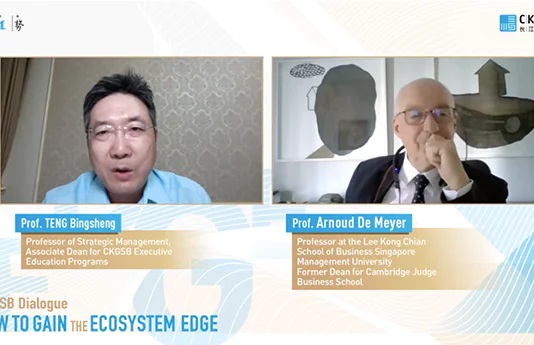In which sectors are Chinese companies outperforming foreign competitors the most? And where are foreign competitors still ahead?
Chinese competitors have become very competitive compared to foreign companies in an increasingly large range of industries such as electric vehicles, new energy appliances, e-commerce and mobility as a service. In other sectors such as medical devices, especially at the top end, foreign vendors still have a very strong position. High-end chips have always been a stronghold for foreign companies, but because of the geopolitical situation, that’s changing too. Foreign companies also still hold a top position in luxury consumer products. Luxury brands from Italy and France have a legacy of “premium-ness” in the minds of Chinese consumers. This is due to a combination of product quality, design and a prestigious brand image.
In terms of consumer products, how do you assess the guochao trend? Are domestic brands gaining significant market share because of it or is the trend shorter lived?
It is too narrow a definition to interpret guochao as just being patriotic towards Chinese brands. Guochao is better understood as a way of understanding the needs of Chinese consumers. Chinese consumers, just like any other consumers, want their brands to cater to their tastes. By nature, they want to have certain aspects of the products that are very China-specific, just like Americans want to see their products as American centered. What we see is that in the marketplace, Chinese brands recognize the needs of Chinese consumers faster and earlier than global brands. But at the same time, strong global brands are not standing still. They are learning and picking up market intelligence quickly. Many of the strong global consumer brands, including but not only luxury brands, are becoming very competitive. In general, Chinese consumers are rational. They choose brands and products based on what they feel provide the best value and price trade-off.
In which sectors do you see the biggest growth opportunities for foreign companies in the next few years?
There are a couple of sectors. One is anything related to technology and innovation, which is growing quickly in China despite the overall macroeconomic conditions. New energy vehicles are within this realm. Another area is life sciences or healthcare in general, as China is trying to improve healthcare delivery. The challenge for healthcare is how to develop new pharmaceutical products and medical devices to deliver higher quality healthcare for patients and for the general public. That area will still provide a lot of opportunities for foreign companies.
The third area will be related to consumer demand as it continues to grow. Consumer taste will keep evolving as China and the world evolve in general. This will lead to new innovations. If companies, foreign or local, can identify consumer trends and develop products and services to cater for these evolving needs, that will present many of opportunities.
Our members (AmCham Shanghai) have cited speed to market and sales & marketing as areas in which Chinese competitors excel. What do you think accounts for the Chinese strengths?
These points have been raised over the many years I’ve been working in China. A Chinese company typically goes to market faster because the decision-making cycle is much shorter. This is because the key decision-makers are on the ground and know what’s going on. They see something, they evaluate and then they make decisions. For multinational companies, the decision-making cycle can be much longer, especially when it comes to new products or innovations. The decision process typically has to go from China back to headquarters, and then headquarters will take some time to evaluate before they make a decision.
The other thing is that the communication is usually more complicated in a foreign company because not everybody in the headquarters thinks about China every day, whereas the China team would think about China constantly. Headquarters manages the global business, and China may be a very important market, but it’s only one of many markets, so the mind is not always on China. When an important idea comes from China, it takes headquarters some time to understand, evaluate, appreciate the context, listen carefully to the local team, and then make a decision. That takes a long time, whereas the Chinese company would already have made a decision once or even a few times over. The gap in the speed to market is significant in many cases.
Sales & marketing is another area in which the Chinese excel compared to Western companies. The Chinese consumer is evolving very quickly and is in particular becoming very digitally savvy. Chinese consumers expect companies to relate to them, which is very different to a typical consumer from the West. There are certain ways that brands will need to connect to consumers through digital means in China. It’s very different than what Western companies are used to in their home countries. One example is KOLs. There’s KOL marketing in the US, but China is out of their league with KOLs. They are prevalent on platforms like Xiaohongshu and Douyin (the Chinese version of TikTok). KOLs may not be the most prevalent marketing channel in most Western countries, but in China they are a must. How do you connect with your consumers through these digital channels so that you market to them almost one-on-one? You can argue whether or not this is the right approach, but what ultimately matters is the performance.
Could foreign companies catch up as long as they’re localized enough to have their own KOLs?
Even though you may have a director of marketing here on the ground in China, and even if they have a lot of decision-making authority and know what to do, they nonetheless need to align somewhat with the global marketing strategy or direction. They need to explain their strategy back to headquarters and headquarters has to be willing to go along with it. And that usually takes time and effort, so the decision-making cycle will be longer and may not be fully adapted to the Chinese consumer context, whereas Chinese companies can do it without these considerations.
Can this be solved by giving more authority to the local team? Or do we need to live with the fact that foreign companies will always have a longer decision-making cycle?
[It will be an obstacle] until and unless local empowerment is fully developed, but it’s also a double-edged sword for multinationals. Based on my personal experience, it’s not that multinationals don’t want to empower [the local teams]; but they want to feel comfortable that the empowered team will be able to make the right decisions consistently. Who can guarantee that [this will happen]? You may value those people, but sometimes things don’t happen in the way you expect. Global CEOs all understand the need to [empower local teams], but they also find practical constraints in making it happen.
If a company that was not in the China market asked you the best strategy to enter a space where there’s already a lot of domestic competition, what would you recommend?
Let’s assume it’s a consumer product like coffee, where there are no regulatory barriers. You need to ask yourself, is my product fundamentally appealing to Chinese consumers? When I started consulting in China 30 years ago, people said the Chinese wouldn’t drink coffee. People also said at that time that Chinese wouldn’t eat cheese. One of my early clients was a very famous pizza chain, and they were ultimately successful in China. Sometimes it’s just a perception. I would suggest that companies really look through the veil to understand what will move the dial from the consumer standpoint. If you have something that’s really good, that you think the Chinese community could potentially like, you need to deeply study and understand [the consumers] to discover whether or not the value proposition is true. You can also look at what local companies have done. Despite its late start, Luckin Coffee now has more stores than Starbucks in China as it has leveraged social media to build its popularity. Bubble tea brand Hey Tea is also popular on social media and is famous for its modern interior design, photogenic packaging and innovative drinks. I wouldn’t say that because China is a big market, you must come. You have to be sure that you can make money from the market, otherwise you shouldn’t come.
If you have something that’s really good, that you think the Chinese community could potentially like, you need to deeply study and understand [the consumers] to discover whether or not the value proposition is true.
How do talent attraction and retention factor into competitiveness? Are Chinese companies better at getting talent?
I’ll talk specifically about private Chinese companies. Chinese talents are beginning to have a self-sorting process. They will sort out what types of people would likely work well and survive in a Western multinational environment, and what types of people would work well and survive in a Chinese environment. People who will join and ultimately do well in the Chinese environment don’t care much about processes. They look for much faster upward mobility and quick decision making. They’re not intolerant of ambiguous working environments or ambiguous decisions. They’re okay with authority that tells them exactly what to do. The people who choose to work for Western multinationals are perhaps less open to risk but would like to work in a more organized environment with clearer processes and policies. They want to have more discipline and would prefer not to work in a 9-9-6 environment. They want to have a more reasonable lifestyle and they may prefer more international exposure. I wouldn’t say there is a challenge in attracting talents, as there are plenty of talents in China. It’s just a matter of what type you are able to attract. Both sides have a lot of people to choose from. The battle will be between companies within the same category. For example, GE will be competing with Siemens or Philips more than it will be competing with Huawei to attract talent.
What opportunities will advanced technologies like AI bring to the competition landscape?
I study AI from the strategy and management standpoint. It is going to fundamentally change businesses in many ways, certainly within internal organizations, e.g., by streamlining organizational operation efficiency. But the focus of my study is on the front end, meaning how companies and customers will interact in the future. Despite us saying for a long time that companies need to be customer-centric, the power between company and customer resides mostly on the company side — I sell you a product, and you don’t tell me how to sell my product to you, though of course suppliers need to know what their customers like. With AI, especially AIGC, the power is shifting quickly to the customer side. Customers are beginning to have the ability to decide on the features of the products or service of the business model that they individually prefer to be offered. In the future, the customer experience will become even more individualized. With generative AI, a customer will be able to design a product of their own liking to an extent that was not possible before. The company-customer relationship is being fundamentally redefined because of technology. This will have many implications for an organization’s strategy and the capabilities of companies in the future.






















